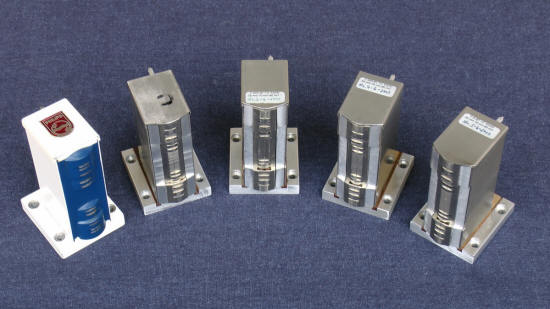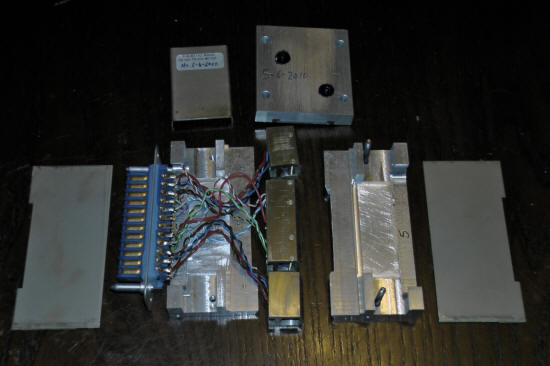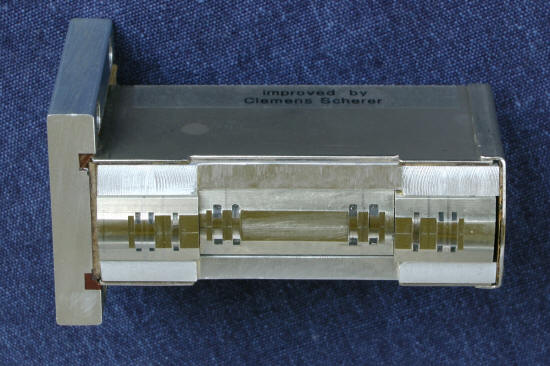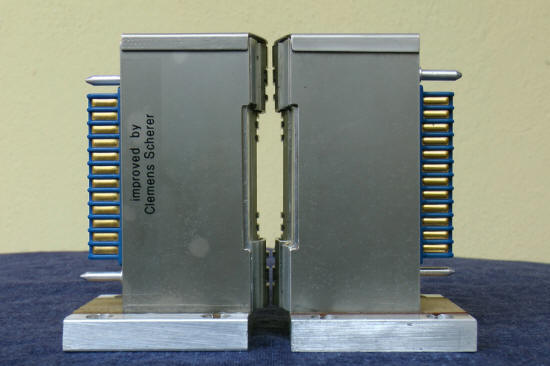Playback of magnetic sound tracks on 70mm cinema prints at the Schauburg |
Read more at in70mm.com The 70mm Newsletter |
| Written by: Clemens Scherer, Karlsruhe, Germany | Date: 02.12.2015 |
 From
left to right the image shows one original Philips sound head, second an
early Winkler sound head with the milled slot still flat, followed by
three later Winkler sound heads that all got the full rework done. From
left to right the image shows one original Philips sound head, second an
early Winkler sound head with the milled slot still flat, followed by
three later Winkler sound heads that all got the full rework done.In case, one is attempting to build up a sound system being able to play back the recordings stored on magnetic sound tracks being found on 70 mm cinema prints will face various problems. Some problems arise from using devices built by the cinema industry decades ago. These devices were developed to play back new struck prints, but already in 2005 we have been looking back on archive prints being between one and five decades old. Over the decades the prints suffer shrinkage. As the shrinkage effect slows down after a couple of years, most prints from all decades show a shrinkage of around 1%. When running these now smaller prints, we could observe that they are swinging left and right in the guidance rollers being placed before and after the sound head. Such a swinging cycle takes only a few seconds. So for a short while the left side tracks are well positioned to their pickups. Then the print is moving right. At the very end only the right side tracks are well taken. Then the print is moving left again. This continues in endless repeating. At the Schauburg cinema in Karlsruhe the decision was made to have new sound heads manufactured, not the usual ones, but with an updated position of the pickups to reflect the average shrinkage of the prints. Running over these sound heads, all the tracks are oscillating more symmetrically to their pickups. One could consider in addition to have new guidance rollers manufactured, optimized for the now smaller prints. But the magnetic recording tracks proved to be wide enough to cover this movement. And we receive a good abrasion image, no sharp edges appear. We had these new heads manufactured in a one man factory, “Winkler Magnetkopftechnik”. A "spin off" of the 60s, later taken over by the son. Then manufacturing all kind of magnetic heads to stay in business. Around 2010 business declined and the factory closed. Dietmar Zingl (Leo Kino, Innsbruck) and Herbert Born (Schauburg, Karlsruhe) placed the final orders. And so "Winkler MKT" ended its business with manufacturing the original product, 10 track magnetic sound heads for cinema theatres. When receiving the first new theatre head, we faced a major problem. Neither normal nor excessive shielding could prevent humming to be clearly heard in the auditorium while silent scenes. It turned out, “Winkler MKT” had altered the internal construction of the pickups, due to our request for them being wider than before. So with the pickups for 70 mm we withdrew this request and MKT made an effort for the pickup construction having the best possible inherent immunity against magnetic fields. After that was achieved, normal shielding proved to be sufficient. |
More in 70mm reading: Schauburg Cinerama, Karlsruhe, Germany. Home of The Todd-AO Festival Teccon Precision Magnetic Recording Heads Why new magnetic sound equipment for 35mm and 70mm prints? 70mm Weekend Review by Clemens Scherer Internet link: schauburg.de |
 The
image shows the main parts, a 10 track Winkler sound head consists of.
The high tech parts are the pickups inserted in three blocks of nickel
silver. These blocks will be held in position by two aluminium brackets.
Mounted together, this core will get a mounting plate fixed in an
electrically isolated way at the back side. Three Mu-metal sheets are
fixed at the other sides around, helping to improve shielding from
alternating magnetic fields. The
image shows the main parts, a 10 track Winkler sound head consists of.
The high tech parts are the pickups inserted in three blocks of nickel
silver. These blocks will be held in position by two aluminium brackets.
Mounted together, this core will get a mounting plate fixed in an
electrically isolated way at the back side. Three Mu-metal sheets are
fixed at the other sides around, helping to improve shielding from
alternating magnetic fields.There were still aspects to improve the overall construction, but after the intricate and time-consuming optimization of the pickups we decided for now to improve pure mechanical aspects by ourselves. • 1. In the aluminium brackets the milled slot for the 35 mm film path was completely flat and regarded too shallow, it had to be given proper shape for being absolutely save from scratching prints, even if a print tends to bend more than usual. • 2. Front and especially back side of the assembled core had to be trimmed for to get all must-be right angles really perfect. • 3. The front side Mu-metal sheet had the edges to be cut und curved, to allow film to be threaded in and out without getting scratched. So at “Scherer Cinema Systems” the already delivered soundheads had to be disassembled for to rework some parts. In sum seven 10 track sound heads got reworked to ensure best magnetic sound reproduction at the Schauburg (Karlsruhe) and at the Leokino (Innsbruck) with many more Todd-AO festivals and 70 mm special presentations in the years to come. Then the design and construction of the altered sound heads proved to be completed to satisfaction, but unfortunately “Winkler MKT” was forced to close down and left the new sound heads to be unique specimen. |
|
 This
image shows a reworked sound head. Well recognizable the 10 pickups and
some Mu-metal shields placed in between, all composed in three blocks of
nickel silver. This
image shows a reworked sound head. Well recognizable the 10 pickups and
some Mu-metal shields placed in between, all composed in three blocks of
nickel silver.Two blocks with 3 channels each (70 mm) divided by one block with 4 channels (35 mm). The pickups for 35 mm film are now made extra wide to cover the slightly different magnetic stripe and track locations of certain prints (first with foxholes and later even with standard holes) together with the left and right movement of the print due to shrinking. The resulting “excess width scan” can be done with tracks on 35 mm film, as these are clearly separated and each recording track covers nearly the whole magnetic stripe. Picking up the full recording track width all the time avoids loudness variation and improves the SNR significantly. At the Schauburg this proved 35 mm magnetic playback to get close to the 70 mm sound experience of the same movie. To resign “excess width scan” with 70 mm has the advantage to avoid reading additional noise from the unrecorded guard band between the outer recording tracks, which share the same magnetic stripe and avoiding the risk of crosstalk between these channels. Anyway with current technology it turned out to be impossible to further reduce the space between the directly neighboured pickups, due to the coils inside already using up all space. |
|
 This
image shows the visible proof that the latest reassembled 10 track sound
head got the tracks positioned exactly like the already tested
reference. This
image shows the visible proof that the latest reassembled 10 track sound
head got the tracks positioned exactly like the already tested
reference.In addition, new preamplifiers were built, optimized for these new high impedance sound heads, allowing to remove the usual isolating transformers from the playback chain. This measure is crucial to remove another source for the typical humming with power frequency and other noise from nearby magnetic fields. In contrary to electric fields, there is no perfect shielding from alternating magnetic fields. This circumstance makes transformers to be more or less an antenna for alternating magnetic fields in the projection booth – if not protected by an expensive design like the soundhead itself. Especially in conjunction with such low level signals, that have to be amplified by around 40 to 70 dB. In succession the necessary electrical isolation had to be moved to the sound head and is hence supported by the new design. Further in the chain any equipment can be used, being able to process the Dolby treatment for all the various sound formats one intends to play. At the Schauburg an upgraded CP 200 does this job, supporting all the sound formats ever defined for 70 mm prints. |
|
| Go: back - top - back issues - news index Updated 22-01-25 |
